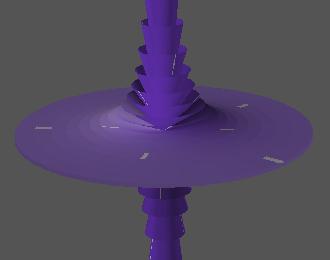Fall 2002 Schedule:
Abstracts
9 October
Farshid Hajir, UMass Amherst
What Is The ABC Conjecture?
Abstract
In 1985, Masser and Oesterlé introduced a new conjecture about
ordinary integer sums a+b=c, which has very quickly become a central
question in number theory. Other than an analogue which holds for
polynomial identities, and some computational work, little is known
about abc. I'll give the (quite elementary!) statement of abc, give
some examples, and explain its relevance in a variety of
contexts.
TOP
23 October (This talk had to be moved from 16 October since UMass is on a Monday schedule on that Wednesday)
Frank Sottile, UMass Amherst
What Is A Hopf Algebra, and What Do Hopf Algebras Have To Do With
Combinatorics?
Abstract
A Hopf algebra is an algebra whose linear dual is also an algebra,
with some compatibility between these two structures. This
uninformative definition leads to an object that pops up quite often
in mathematics. One such area is in combinatorics, where G.-C. Rota
pointed out how combinatorial objects naturally posses some Hopf
structure. In fact, under this combinatorial Hopf structure, many
things that we would like to count transform naturally, yielding new
tools in combinatorics. This talk will introduce you to some Hopf
algebras, and explain how they arise in combinatorics. (And maybe
explain the more pressing question: what *is* combinatorics?)
TOP
30 October
Tom Braden, UMass Amherst
What Is A Toric Variety?
Abstract
Toric varieties provide a large collection of examples in algebraic
geometry for which many things can be computed very explicitly.
A polytope in euclidean space determines a toric variety, and
many features of the variety can be seen directly from the polytope.
I will talk about one such story: the cohomology groups of the
variety correspond to questions of counting faces of the polytope.
TOP
6 November
Jin Feng, UMass Amherst
What Is Optimal Control Theory? What Is Max-Plus Calculus?
Abstract
In Optimal Control Theory, one of the main difficulties is the
NON-LINEAR nature of the equations involved. An example would be the
study of the nonlinear Hamilton-Jacobi equation, which describes time
evolution of optimal pay-off functions. However, linearity and
nonlinearity are relative to the usual algebraic operations of
ordinary addition and multiplication we use on the real line. If we
replace the usual plus by the max, and the usual times by the
usual plus, we discover a new structure, called Max-Plus, under
which the Hamilton-Jacobi equation becomes linear! I will explain how
such a viewpoint will allow us to see some classical results by
analogy with linear analysis.
Note: This talk will help provide some background knowledge for the 7
November
Colloquium by
Wendell Fleming On Max-Plus Calculus and Stochastic Control
Theory.
TOP
13 November
Farshid Hajir, UMass Amherst
What Is the Absolute Galois Group of Q?
Abstract
The solution to many types of questions in number
theory boils down to understanding symmetries
of roots of one-variable polynomials. These symmetries are
encoded in one gigantic topological group Gal(Q^alg/Q), the absolute
Galois group of Q. I'll define this, talk about its basic properties,
and explain how it encodes, for example, solutions to equations of
type y^2 = x^3 + ax + b (elliptic curves). I'll try to convince you
that if we could really answer the question of the title,
(it all depends on what you mean by "is") then many of us would have to
look for new kinds of problems to study ...
TOP
20 November
Sarah Witherspoon, UMass Amherst & Amherst College
What Is (co)homology?
Abstract
(Co)homology is a very useful tool in many branches of mathematics.
Here we will focus specifically on the homology of topological spaces
such as spheres and tori, that is on particular abelian groups
associated to such spaces. These homology groups enable us (sometimes)
to distinguish among different spaces. We will discuss the related
Betti numbers, Euler characteristic, and genus, which all indicate the
number and types of holes in a space. Time permitting, we will also
look at the dual notion of cohomology.
Note: In addition to helping you understand the rings Tom Braden was
talking about at the end of his seminar, this talk will provide
background for the Valley Geometry
Seminar on Friday 22 November.
TOP
4 December
Rob Kusner, UMass Amherst
What Is a Sphere Eversion?
In the last millenium the notion of regular homotopy (a.k.a. "bicycle
chain magic") was formulated and explored by differential topologists
such as Whitney, Graustein, Smale and Hirsch. One remarkable
consequence is that there is a regular homotopy from the standard
embedding of sphere in 3-space to one with the opposite orientation.
In other words - without ripping, tearing or creasing - one can deform
a sphere into one which is inside-out (or a left-handed glove, with
the wrist-hole sewn up, into a right handed one ;)! We'll try to
understand the "why" and "how", as well as the "what"....
TOP
The picture above was created by
Paul Gunnells.
It visualizes the natural action of the group
of units of a complex cubic field on 3-space.
Consult
Paul for more details.
Last modified: 22 November 2002 by
Farshid Hajir


 Talks begin at 3:00pm.
Talks begin at 3:00pm.
 Refreshments at 4:00pm.
Refreshments at 4:00pm. Driving Directions and
Campus Maps
Driving Directions and
Campus Maps
 Overview of the Seminar
Overview of the Seminar
